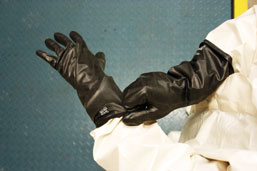Information for Industrial Workers – ortho-Toluidine
Information for Industrial Workers
We know that o-toluidine can cause cancer. If you work with o-toluidine, there are ways you can keep yourself and your family safe.
Keep yourself and your family safe
- Be sure you use personal protective equipment (PPE) that will keep you from breathing in o-toluidine. If a respirator is needed, use one that is NIOSH-approved with an organic vapor cartridge (containing activated charcoal) or one that supplies breathing air. Do not use disposable filtering-facepiece respirators designed to protect against dusts since they don’t provide protection against o-toluidine.
- Good instruction and supervision are necessary to ensure skin protection against o-toluidine. Skin protection includes wearing gloves, protective arm sleeves, lab coats, and boot covers. When using gloves, remember that not all glove materials prevent o-toluidine from going through the glove and getting on your skin:

- Gloves made from butyl rubber, and some trademark materials, provide the best protection.
- Gloves made from neoprene would be expected to provide some protection (rated 1-4 hours of protection) against o-toluidine.
- Some laboratory tests have found gloves and other PPE made from polyethylene and polyvinyl chloride do not protect against o-toluidine.
- Natural rubber, nitrile rubber, and polyvinyl alcohol have not been tested for protection against o-toluidine.
- Glove manufacturers will have the most up to date information on whether a glove you are using will offer you the proper protection.
- For more information about glove selection and information concerning the protective qualities of different types of glove materials, see the Quick Selection Guide to Chemical Protective Clothing, 5th edition (2007) by Krister Forsberg and S.Z. Mansdorf (Wiley-Interscience, Hoboken, NJ; ISBN 978-0-470-14681-1).
- If your worksite offers showers and locker rooms, use them. If you do not shower or if you wear your work clothes home, you can expose your family to chemicals. If your worksite does not have showers or a changing room, shower and change immediately after you get home. Wash your work clothes separate from the other clothes. Chemicals that are on your work clothes can still get on other clothes if they are washed together.
- If your worksite offers a medical surveillance program, use it. There is a reason it is in place. If your worksite does not have a surveillance program, be sure your doctor knows you work with o-toluidine. Your doctor may want to monitor you for bladder cancer, since o-toluidine is a known cause. There are medical tests that can tell you whether you’ve been exposed to o-toluidine. Talk with your doctor to learn more and to decide whether this would be beneficial.
- If you are concerned that you are being exposed to o-toluidine or another workplace hazard, contact our Health Hazard Evaluation Program and request to have your work environment assessed for free. For more details and to fill out a request, visit the NIOSH Health Hazard Evaluation website.
- Learn what your employer can do to help keep you safe.
- Find more information and resources related to o-toluidine.
